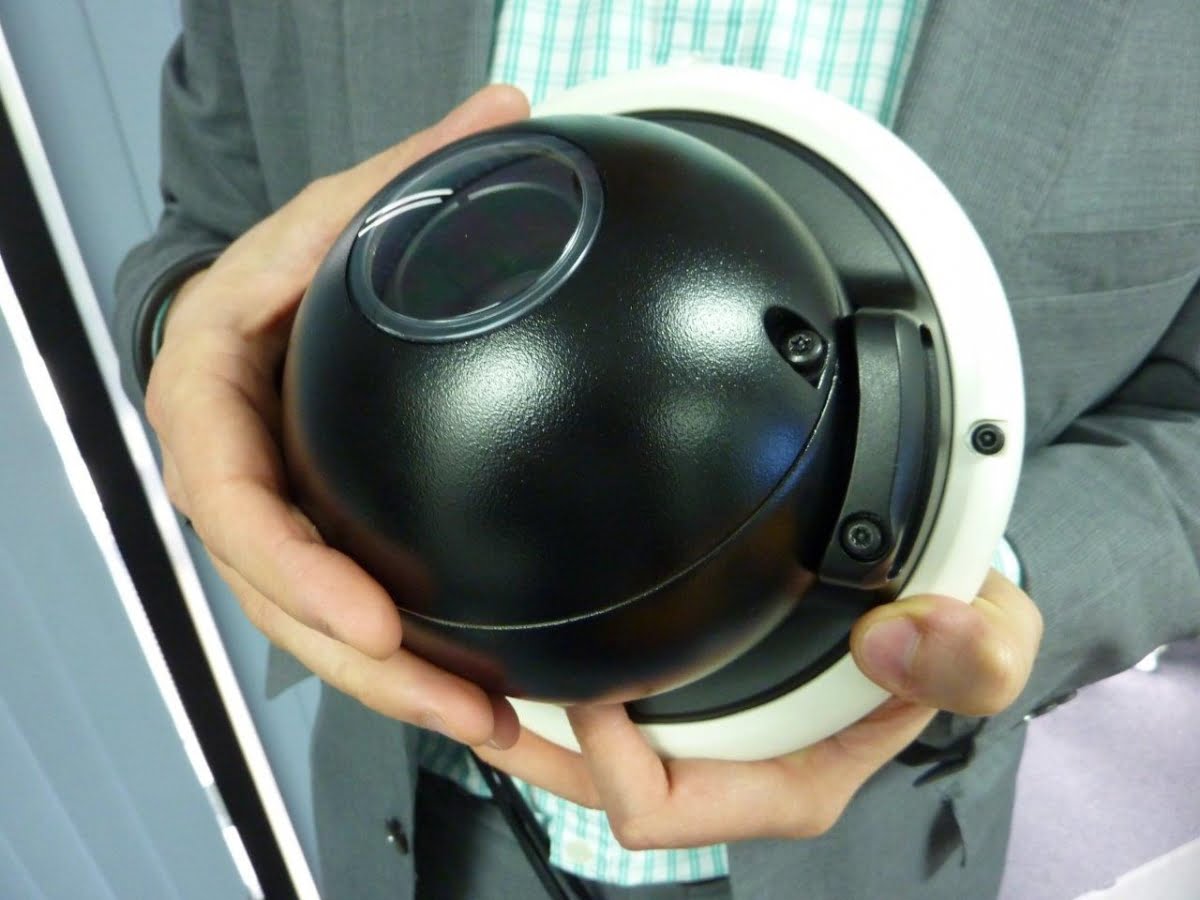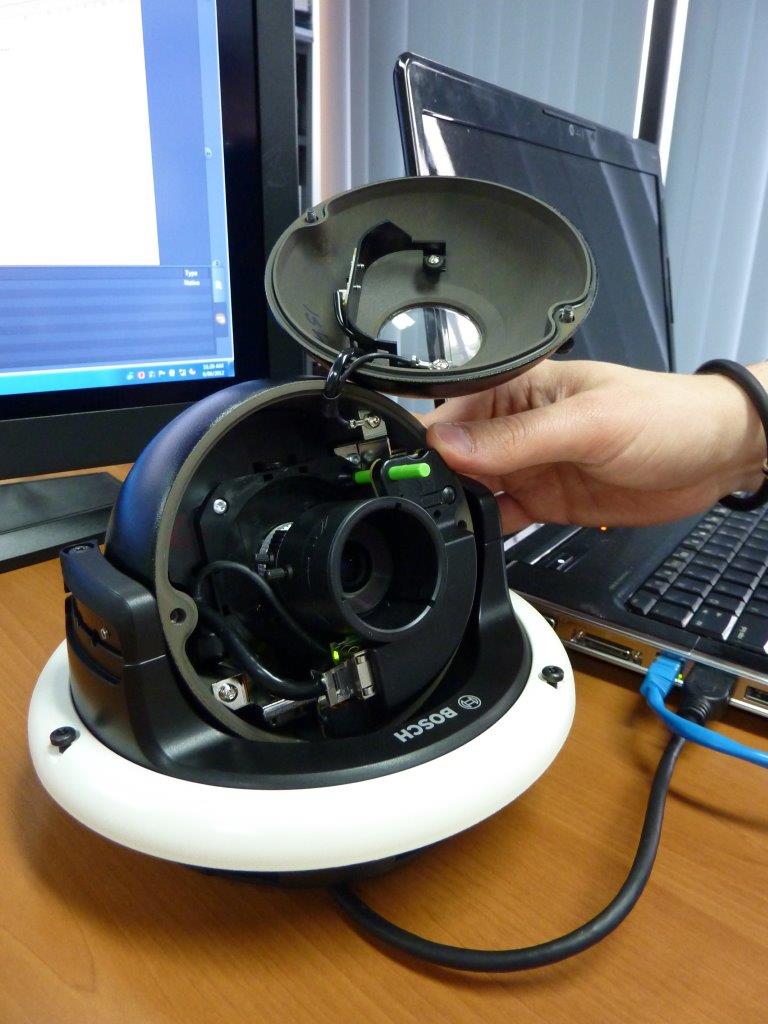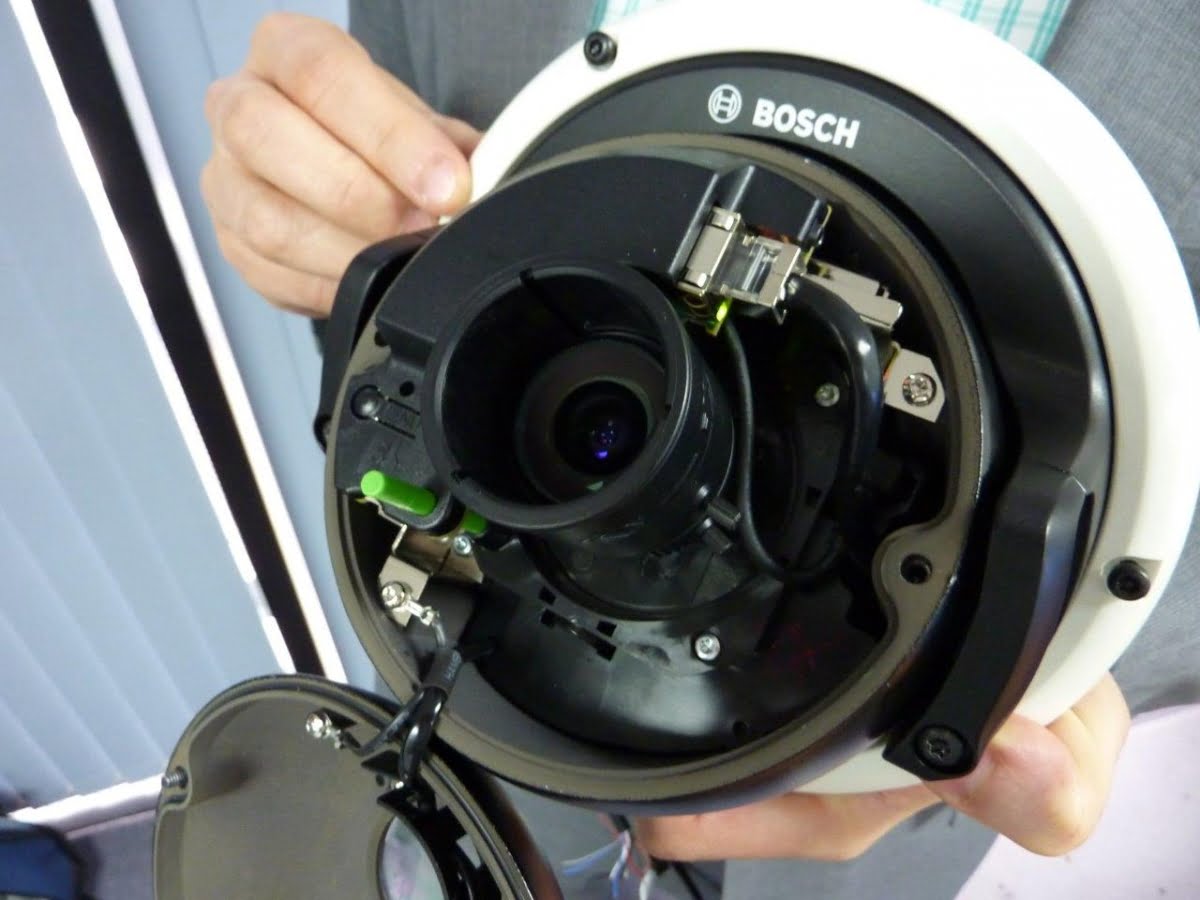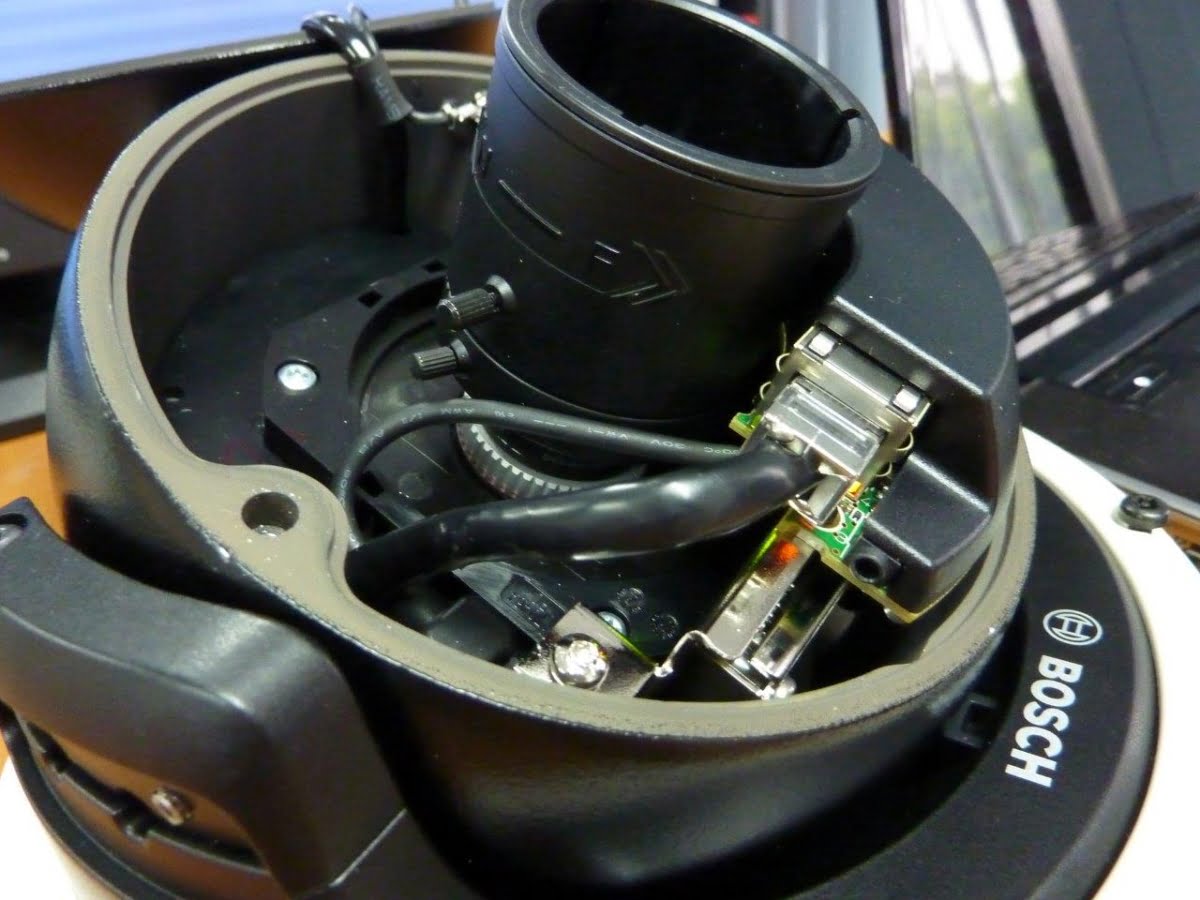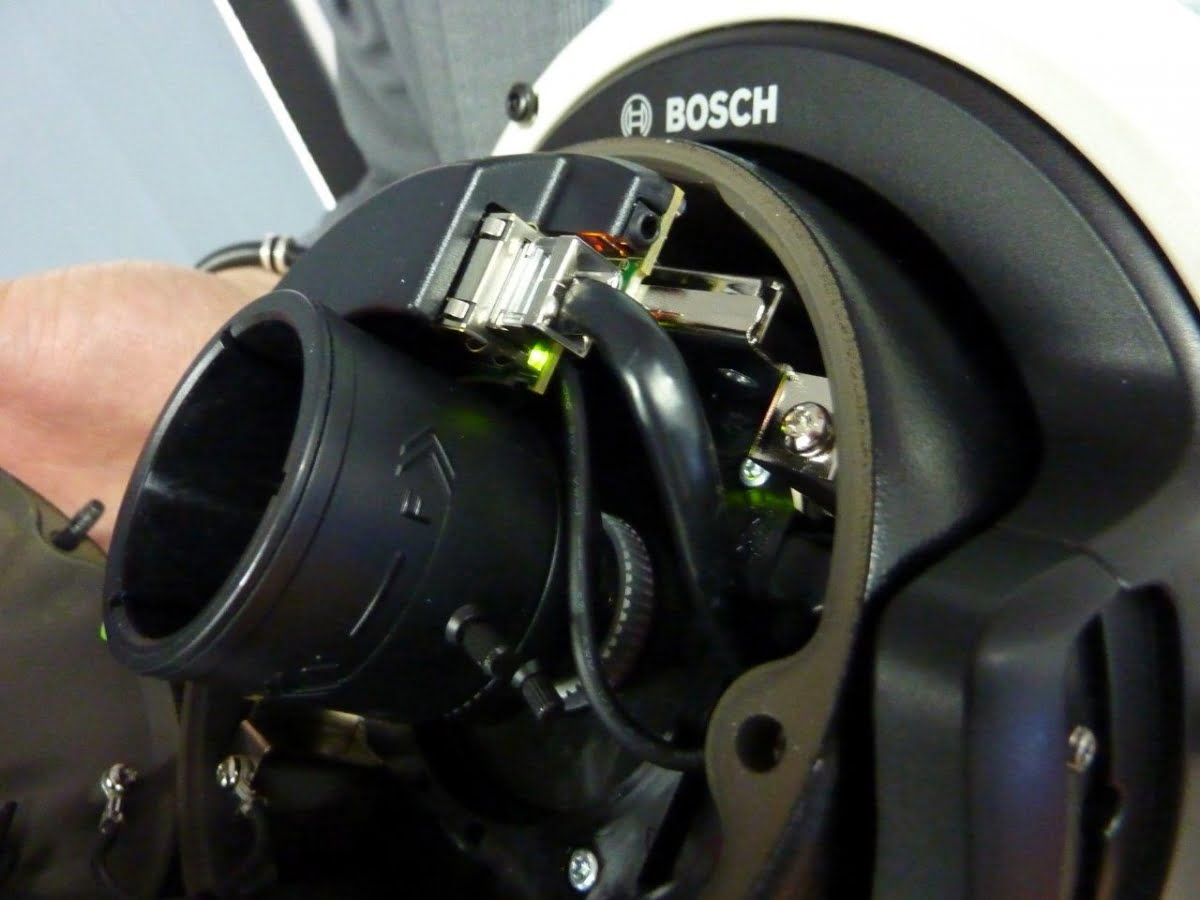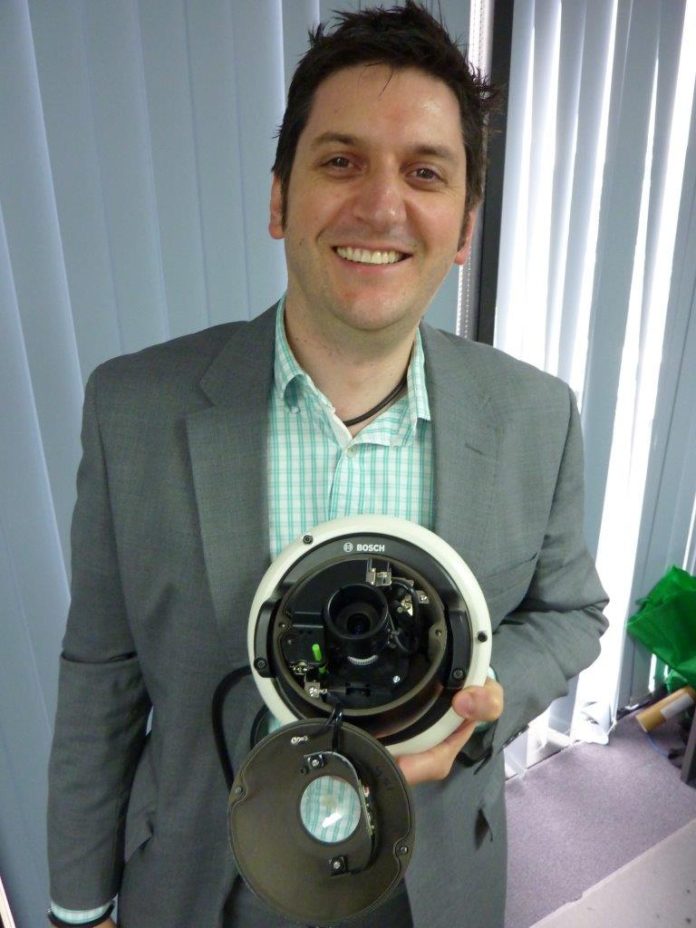Bosch’s new FlexiDome NDN-832 is a 1080p HD day/night PoE adjustable dome camera. It features a ½.7-inch CMOS progressive scanning sensor, motorised auto backfocus, high impact vandal resistant enclosure, quad streaming, and ONVIF compliance and plenty more.
OTHER key features of this unit include 1920 x 1080 HD resolution at 25ips and compression formats including H.264, M-JPEG and JPEG. You can employ a pair of independently configurable H.264 streams, as well as 2 additional streams, one MPEG and one HD I-frame. Together the 4 streams support a range of transmission and recording options.
I take a quick test drive of the camera with Bosch’s Phil Brewer and my initial reaction holding the camera in my hands is recognition of the physical quality of this camera as well as surprise at the highly functional design. The NDN-832 is a fixed dome but it’s adjustable a bit like an eyeball. In my opinion the NDN-832 has some of the same level of quality as Bosch’s MIC range – it’s heavily built for rugged duties.
For a start, the unit is rated IK10 rated vandal protection thanks to its cast aluminium housing, polycarbonate camera window and a hefty inner lining that’s designed to handle impact forces of up to 55kg. There’s also an extended operating temperature range (-50 ºC to +55 ºC) and a heater. Built to meet the IP66 rating, the camera is watertight and secure from dust ingress.
Perhaps the coolest feature to me is a ‘bubble-less’ dome design which Brewer says is designed to minimize optical distortions.
“A problem with megapixel domes is that as the resolution gets higher the curvature in the plastic distorts and attenuates the image, effectively reducing resolution,” he explains.
“With this new FlexiDome HD we’ve controlled the curvature on the dome cover to maintain optical correctness. It used to be that a fixed camera was always better than a dome for a range of reasons including the bubble effect – this camera offers installers and end users a new dome paradigm.”
Given its external designation, the camera comes with a choice of telephoto, mid-range and ultra wide angle lenses. Each lens option is specifically matched to the sensor to ensure full resolution, even in the corners. What this means is that operators can zoom in to any part of a scene to examine specific details, such as a person’s face or a car number plate, without losing clarity. For instance, the 1.8 to 3 mm, optically corrected, ultra wide angle lens provides strong performance throughout the scene without the need for de-warping software.
“This camera is essentially the same as fixed body HD camera we released recently. It has the same optical qualities – the same overall engine and a slightly different but high quality lens”
Now Brewer shows me the adjustable dome function and it’s very neat. The camera has arms on either side and the camera sits between them can be rotated through 180 degrees even after it’s been installed. You loosen a pair of grub screws to adjust the camera and then tighten them to lock in the new position before popping the plastic trim caps over the screw heads.
“This camera is essentially the same as fixed body HD cameras we released recently,” Brewers explains to me. “It has the same optical qualities – the same overall engine and a slightly different but high quality lens. The idea is that if people put in the more popular dome cameras they are getting equal quality to fixed cameras, not something that’s less capable.”
Same as the rest of the HD range, this rugged Flexidome has built-in HD-optimised intelligent video analysis (IVA) that flags any events on-screen, so that operators are less likely to miss suspicious activities. IVA captures comprehensive details of scenes which can be stored for later review using Bosch’s Forensic Search feature.
Other useful features include 4 programmable privacy masks and bundled Bosch video client software which provides a user friendly interface for installation and configuration of the camera. There’s a wizard to make setup of multiple cameras easier. The latest versions of the camera sport an SDXC card slot which offers the potential for 1.2TB of flash storage onboard. Nice.
Testing times
To get the test drive underway we jump onto the camera through the browser on Brewer’s laptop and access onboard software via the camera’s web interface – it’s the same as all Bosch’s cameras. You can program the unit by laptop or via the onboard video client, which is a free 16-channel viewer.
“Some of the nice things include that you don’t need to use a laptop to set this camera up,” Brewer points out. “There are menu buttons on the camera and installers can operate these manually to check the IP address, check some camera settings, defaults, subnet masks.
“I think it’s fair to say that IP cameras are not as easy to install as analogue for newcomers to IP but they are more powerful, more convenient and give end users more capability. For this reason, when it comes to supporting installers transitioning from analogue to IP we have to put in some features to make it easier.
“Bosch has done this with an intuitive user interface with lens wizard, an analog video output and one-push auto focus makes on-site installation easy. There’s also a motorized, advanced auto back focus helps reduce installation time by more than 50 per cent.”
While I take some photos, Brewer works on setting the camera. The camera are we are looking at has a 3.8-13mm lens – there’s a powerful 9-40mm lens as well – and given the strong performance of the smaller lens it’s obvious the big boy would be excellent at longer ranges.
“The auto-backfocus is a strong feature,” Brewer says. “I think at 720p you can backfocus by eye but when it comes to 1080p and larger megapixel cameras, that’s simply not good enough.”
As a challenge we decide to point the camera straight out the window into the wide blue yonder. There’s plenty to focus on in the foreground and background and plenty of moving trucks to give a sense of underlying motion blur. It’s a sunny day and Brewer’s windows face in a northerly direction making penetrating the glass a difficult proposition.
Phil aims the camera out the window and runs the autobackfocus and the camera busily winds its lens back and forth to establish the best focal length for the view. Once it has made up its mind, the scene comes into focus and we can judge camera performance. It does a really good job out there, I say. Good depth of field as well. I can see individual leaves on the trees across the road – maybe 15 metres away. The camera handles the semi-trailers grumbling past the window with aplomb – no sign of motion blur in daylight.
My impression is that Bosch’s 1080p HD camera handles this backlight very well indeed. It got through the glass, through the bloom of direct sunlight and out into the scene with no dramas whatever. Images are sharp, colour rendition is true. The overall impression is quality – typical Bosch.
In a pleasing challenge of cognition I try to see signs of a total lack of bubble-derived image distortion by scoping the outer edges of the scene for something that shouldn’t be there. Whatever it is I’m looking for, I don’t see it. The image is balanced in every way as far as I can tell. We start reading the names on the back of cars in the carpark. Face recognition would not be a problem, I say. Then we look at the scene with a little more zoom on the lens. It’s a great image.
To show low light performance we turn to some demo recording. We look at the camera in a warehouse in good light. The image quality is excellent – you can almost read labels at closer ranges. The scene is about 50m deep (the camera is fitted with the 9-40mm lens) and performance is great throughout.
After this we take a look at the same camera in the same scene without lighting assistance at sub 1 lux and it does ok at closer ranges – you’d see a figure but not a face. Importantly, there was no sign of motion blur in the dark, which means the Bosch processing engine is good quality. I think with incidental streetlighting or ambient area lighting you’d probably get colour performance in some scenes but I did not see this on the test.
What I did see was the same 50m internal scene with adjacent IR lighting activated and the performance is brilliant in night mode with IR. And IR helps the bit-rate in low light – about a 50 per cent reduction, Brewer says, which sounds right to me.
Conclusion
This camera is right up there with the best of the new product right now. It feels like a really tough monkey in the hands and its performance specifications are first rate. If you needed a quality fixed camera for a challenging external environment with a potentially variable target area it would be hard to go past the Bosch NDN-832.
Trade price for this unit is just under $A1500 which is good value for an IP66, IK10 camera with the sort of capabilities this camera has. Real world performance is great and that flat lens cover makes this camera a real standout. This camera is well worth a look. ♦
By John Adams
Fact File
Features of the NDN-832 FlexiDome 1080p:
* ½.7-inch day night CMOS with progressive scan
* 1080p HD
* Motorised auto back focus
* IP66 weather and IK10 vandal resistant ratings
* ‘Bubble-less’ dome house housing
* Quad streaming
* SDXC memory card slot (1.2TB format).
“I think at 720p you can backfocus by eye but when it comes to 1080p and larger megapixel cameras, that’s simply not good enough”

